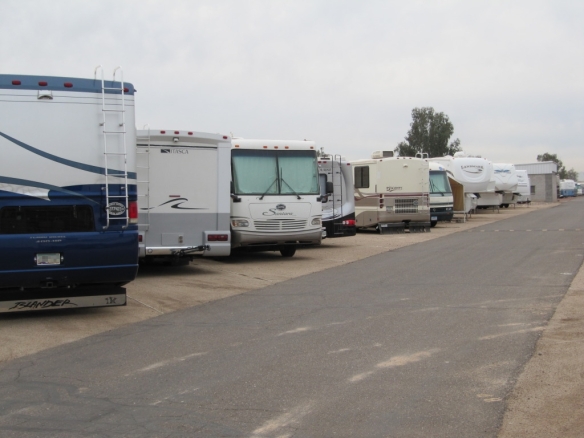
1. Clean and Check all Seals
Before placing the rig in storage give it a good wash and wax. The wax will help protect the RV from sun damage and keep dirt build up down. A good coat of wax also makes cleanup after storage much easier. When washing pay special attention to the roof. Most of those evil black streaks come from dirt and road grime on the roof, so the cleaner the better for the whole rig. After the rig is all clean have a close look at all silicon seams, caulking and rubber seals. If anything is cracked or worn looking now is the time to repair it. One of the most expensive RV repair bills you can get is from water damage and most times it happens during time spent in storage.
2. Ventilation
Keeping moisture out of the RV is a major concern. If any moisture develops it can lead to mold growth and musty smells when you retrieve your RV from storage. I find by far the best way to keep the interior of the RV dry is to leave the rooftop vents open. Equalization of air temperature inside and outside the RV seems to be a big key to stopping moisture problems and the open vents do the job well.
3. Blinds and Curtains
Another way to combat mold growth is by not using the full night time shades. Store the RV with the translucent daytime shades drawn which still allows daylight to penetrate.
4. Slide Outs
Keep all slides retracted when storing the RV. This way the mechanical parts, roof, slide toppers and rubber seals are not exposed to the elements and there is less chance for leaks. Before placing the RV in storage, clean the rubber seals, roof and mechanical parts underneath. Apply some Protect-All rubber seal conditioner and slide rail corrosion protector. On the inner seals rub on some baby powder to keep the them from sticking.
5. Bugs and Rodents
Different parts of the country will have different problems with pests, and most of them can cause some sort of grief when storing the rig. First thing to do is make sure all external openings are blocked off or screened. Popular spots for bugs to set up shop are rooftop plumbing vents, inside the exterior fridge panel and vent, the furnace exhaust and air intake piping. Most RV parts outlets sell made to fit screening for these openings. The best way to limit them picking your RV as a happy home is to make sure to remove all possible food sources and nesting materials. Even things you wouldn’t think of like soap, toothpaste and paper towels. They generally won’t hang around and nest if there isn’t a good supply of food.
6. Electrical
Turn off all electrical using a battery disconnect switch. This way there will be absolutely no drain on the battery bank and you won’t have to worry about dealing with a dead battery bank when you go to pick up the RV. Thing to remember though is to make sure the batteries are fully charged first. A fully charged battery will be OK in cold weather and usually not freeze.
7. Plumbing and Tanks
The temperature plays the biggest role in how to prep the RV for storage when it comes to plumbing. If there is no chance of freezing and you are only storing for a few weeks you can do very little. Flush out the waste tanks and then add back a ¼ tank of water to keep them from drying out inside. For the fresh water, fill it and add a ½ cup of bleach and then run it into all the pipes. That way I get to disinfect the water supply plumbing as it sits and nothing can grow in it. If there is any chance of below freezing weather, remove all water from the plumbing system including the water heater tank. Add antifreeze into the piping, valves, drain “P” traps and a little bit into each waste tank. Remember to remove any other liquids that may freeze and crack their containers to avoid unanticipated messes in the RV. An example would be dish washing soap.
8. Security
Motorhomes are a little harder to break into and steal but fifth wheels are an easy target. Attach a hitch lock to the king pin. Some folks will also chain the wheels or use a wheel lock. The best thing to do is leave it in a location that has some type of onsite security or at least someone that keeps an eye on things. Making your RV a difficult target is the best defense. Thieves are generally lazy and will move on looking for an easier score.
9. RV Insurance
Make sure to contact your RV insurance company and see if you have the proper insurance in place. Don’t trust that a storage lot is going to cover any losses. Most policies for “storage only” coverage are very cheap and well worth it for peace of mind.
10. Tires
Improper storage of tires causes a great many of those blow outs you hear RVers talking about. Leaving the motorhome or trailer parked in the same spot on the tires for extended periods weakens the tire and may lead to sudden catastrophic failure
11. Go Check on it
Finally, we can all get lazy or forgetful, out of site out of mind, but it’s well worth stopping by and checking in on your RV from time to time. Problems can be nipped in the bud before they go from minor little problems to larger, more expensive issues. Two big things to look for are signs of rodent droppings or moisture intrusion each can cause expensive damage.
